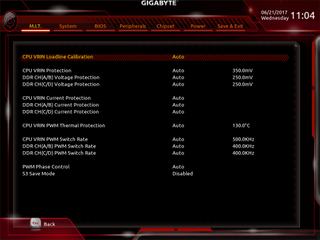Gigabyte GA-X99-Designare EX Review
Why you can trust Tom's Hardware
Firmware & Overclocking
UEFI Interface










The Designare EX shares the same UEFI interface and features we outlined in the X99P-SLI review. You can check there for more detail. You still get the same Easy and Classic modes, the same slow mouse tracking throughout, and the same problematic fan sliders controls.
CPU Overclocking



Although the Designare has the same overclocking controls as the X99P-SLI, it can't hit the same clock rates stably. Our sample can't reach the 4.2 GHz mark, so it's more than 100 MHz slower than its less expensive cousin at 4.147 GHz (41 x 101 MHz BCLK ). In typical Gigabyte fashion, the BCLK creeps a little above the UEFI setting for an actual pace of 101.16 MHz, giving the 6 MHz bump over the expected 4.141 GHz. It barely beats the X99 Taichi for a higher overclock, but does it on a much lower voltage (only 1.31V compared to 1.34V ).
BCLK Overclocking

The Designare demonstrates Gigabyte's usual BCLK behavior both in the vacillating (stock 100 MHz bounces between 99.75 MHz and 100.17 MHz) and in extra flexibility. The 1.0 and 1.25 straps can reach 102.2 MHz and 128.3 MHz, respectively, which is just shy of matching the X99P-SLI, but is a greater range than the Gaming Pro Carbon or Taichi.
Power Control



Voltage and power control remain the same on the Designare. Overall configuration options are decent but not as detailed as some tweakers would want.
RAM Overclocking




Overclocking the memory is rather simple on the Designare, as the XMP DDR4-3200 CAS 14 setting was as high as it would go. Once again, this surpasses the Taichi. It also shares the lopsided RAM voltage cheat of the X99P-SLI, with 0.35V on the A and B channels and 0.25V on C and D.
MORE: Best Motherboards
MORE: How To Choose A Motherboard
MORE: All Motherboard Content
Stay on the Cutting Edge
Join the experts who read Tom's Hardware for the inside track on enthusiast PC tech news — and have for over 25 years. We'll send breaking news and in-depth reviews of CPUs, GPUs, AI, maker hardware and more straight to your inbox.